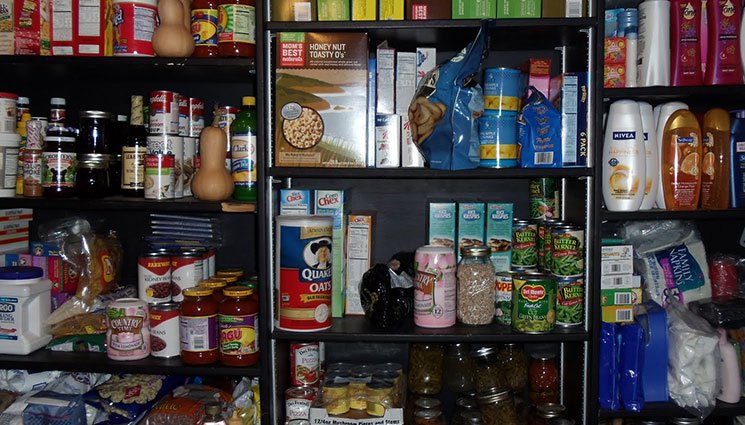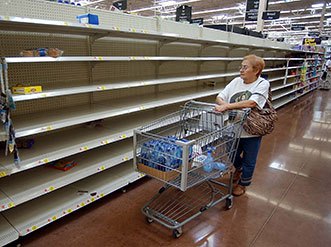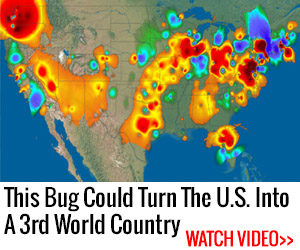Food – 30 Days of Groceries In Your Pantry
When you start to consider prepping, one of the first things you need to start prepping for is food. Simply put, food is one essential you need to live and your family must have a supply of food on hand regardless what the day or your situation is. Because of our just in time supply chain model, most grocery stores do not have more than 3 days’ worth of food stocked. In any type of emergency or disaster situation, the store shelves are cleaned quickly. You do not want to be one of those people who realize you have nothing in the house for dinner and a major snow storm, hurricane or other event is imminent. You will go to the grocery store and find bare shelves like they did during hurricane Sandy. This happens in every instance where people could face the possibility of going hungry. The stores are cleaned out and the larger your city, the quicker the shelves are bare.
Not only will there be no food on the shelves, but the shelves could stay that way for a long time. What if the roads are impassable? What if there is some supply disruption. You could be out of food for a long time and this should never happen. You eat every day and so does everyone else. Running out of food should not be an option for your family at least for a reasonable amount of time.
FEMA recommends 3 days’ worth of food and water to last most common emergencies and I would say 30 days is a better goal to shoot for. If you have a month of food stored in your house you can worry about other things like getting back to your family if you are away from home or not going out in the first place to fight the lines of panicked people who waited until the last-minute.
Storing food can be complicated and costly but it is possible to start with a very simple list of items that you can purchase from your local grocery store or big-box chain like Wal-Mart, Costco or Sam’s Club. I have compiled a simple list of common foods that you can go get today that will allow you to feed a family of 4 for 30 days. If you have more or less people or giants in your family tree then you would need to adjust accordingly.
Basic Foods
I shop at Costco or Sam’s, but you can get all of these at your friendly neighborhood grocery store. You may have to adjust the quantities. I like Costco and Sam’s because I can buy larger containers and have to worry about fewer items, but you can also use Amazon.com. At a store, you can also throw these into your cart and nobody is going to look at you like you are a deviant. If anyone does ask you what you are doing, just tell them you are having a big Chicken Stew or some other neighborhood type of event.
- Rice – First off, buy a 50lb. bag of rice. These contain 504 servings and I don’t know too many people who won’t eat rice. It is simple to cook and stores for years if you keep it cool and dry. This bag at Sam’s costs about $19 now.
- Beans – Next buy a bag of dry beans. This will check off the Beans part of your Beans, Bullets and Band-Aids list. A good size bag is about $5 and makes 126 servings. Buy two if you think your family would like them.
- Canned meat – Cans are great for fruits and vegetables and anyone can find something they will eat. For canned meat, I recommend tuna or chicken because it tastes a heck of a lot better than Spam and you can easily mix that into your rice. For the meat you will need approximately 35 cans. Each can has about 3 servings and this will be the most costly, but they last over a year usually and your family probably eats chicken or tuna on a semi-regular basis anyway so restocking this should be simple.
- Canned Vegetables – you will need about 40 cans of vegetables and again this can be whatever your family will eat. Expect to pay around a dollar each so $40 for veggies to last your family a month.
- Canned Fruit – again, simple fruits that your family will eat. These can even be fruit cocktail if that is the safest thing. At Costco they have the #10 cans of fruit like pears or apple slices and each of these has 25 servings. 5 of these will cost about $25 and give your family their daily dose of fruit.
- Oatmeal – Good old-fashioned oatmeal is simple to cook and store. A normal container has 30 servings each so purchase about 4 of these and your family won’t starve for breakfast. At $2 each that is about $8 for breakfast for a month for a family of four. Could you exchange Pop-tarts? Maybe, but I find oatmeal more filling and less likely to be snacked on.
- Honey– Honey is a miracle food really as it will never go bad if you keep it dry and cool. Honey will last you forever and Sam’s has large containers that hold 108 servings. You can use this in place of sugar to satisfy the sweet tooth. Honey even has medicinal properties and you can use this to add some flavor to your oatmeal for breakfast.
- Salt – Same as honey, salt will never go bad if you keep it dry and helps the flavor of anything. You can buy a big box of salt for around $1 and that will last your whole family a month easily.
- Vitamins – I recommend getting some good multivitamins to augment your nutrition in the case of a disaster or emergency. Granted, rice and beans aren’t the best and you won’t be getting as many nutrients from canned fruit and vegetables so the vitamins help to fill in the gaps and keep you healthy. One big bottle costs about $8. You will need to get a kids version too if you have children small enough that they can’t or won’t swallow a big multivitamin.
All of the list above will feed the average family of 4 for right at 30 days and makes a great start to your food preparations. The meat was the most expensive part but the bill comes to around $500 give or take but this will vary by where you live. Should you stop there? No, but this is just a good starting point and you should expand from here. I would keep all of these items in your pantry along with your regular groceries and rotate these to keep the contents fresh.
What Next?
Once you have 30 days of groceries in your pantry I would recommend looking into storing larger quantities in Mylar bags or purchasing freeze-dried foods and bulk grains to augment your supplies. You would also need to plan for basic necessities like hygiene (hello toilet paper!) and different food items.
What else should you have? I would recommend several large candles (very cheap at WalMart) or a propane powered lantern, matches or lighters, batteries for flashlights a good first aid kit, radio and plenty of water. You should also add bullion cubes and spices in to make the meals more palatable. Is this going to be as good as some toaster strudel or 3-egg omelets from your chickens in the morning? No, but this list above will keep your family alive.
Water is another post, but for a month you will need 120 gallons at a minimum. Storing this isn’t as easy as groceries but there are lots of options.
This should get you started on your food preps and you can build on from here. Let me know if you have other ideas I missed.
Other Self-sufficiency and Preparedness solutions recommended for you:
The Lost Ways (The vital self-sufficiency lessons our great grand-fathers left us)
Survival MD (Knowledge to survive any medical crisis situation)
Backyard Liberty (Liberal’s hidden agenda: more than just your guns…)
Alive After the Fall (Build yourself the only unlimited water source you’ll ever need)
The Lost ways II (4 Important Forgotten Skills used by our Ancestors that can help you in any crisis)
The Patriot Privacy Kit (Secure your privacy in just 10 simple steps)
When you start to consider prepping, one of the first things you need to start prepping for is food. Simply put, food is one essential you need to live and



